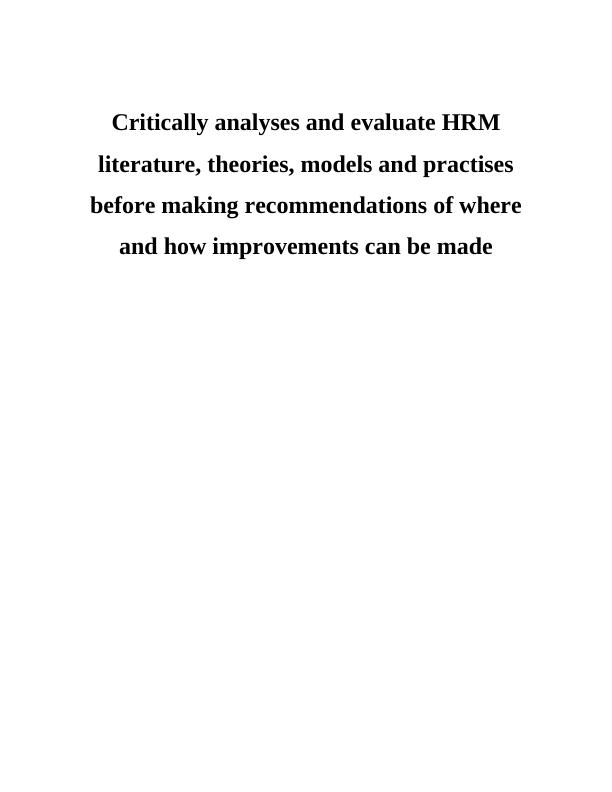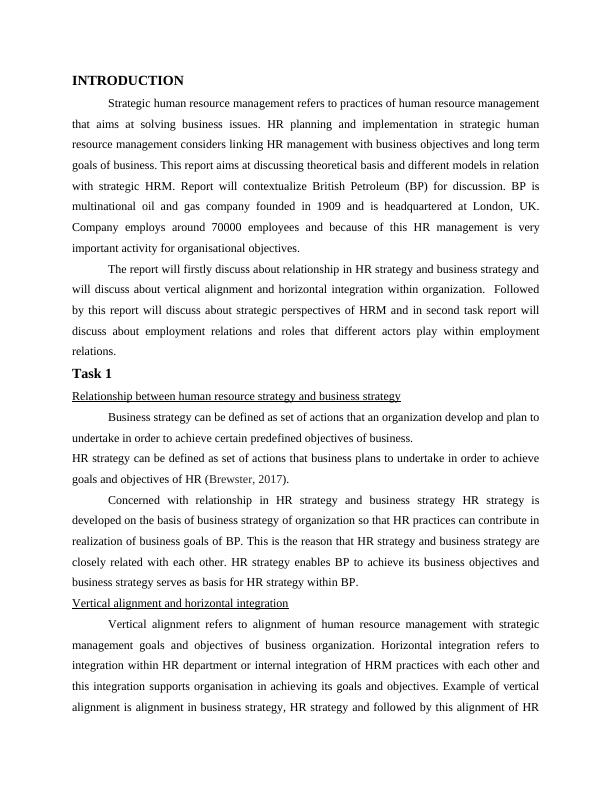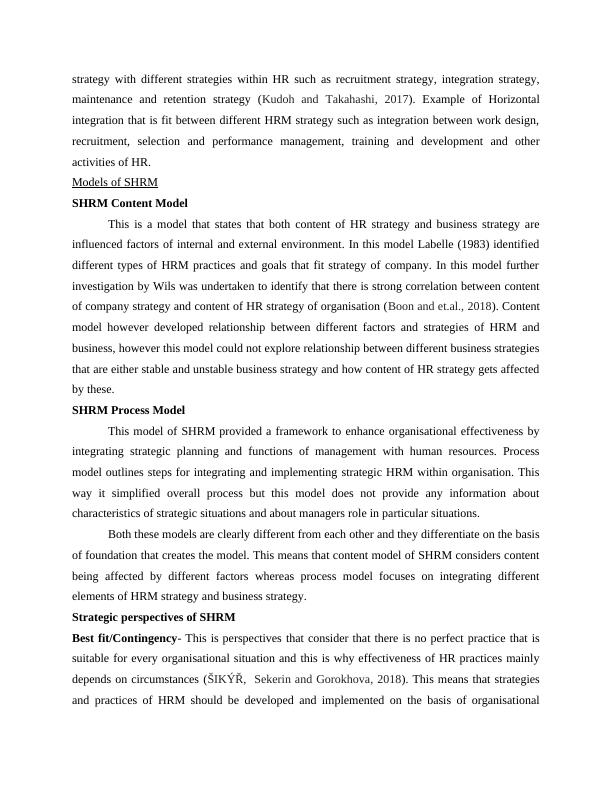Critically Analyzing and Evaluating HRM Literature, Theories, Models, and Practices
Added on 2022-12-26
12 Pages3882 Words5 Views
Critically analyses and evaluate HRM
literature, theories, models and practises
before making recommendations of where
and how improvements can be made
literature, theories, models and practises
before making recommendations of where
and how improvements can be made

Table of Contents
INTRODUCTION...........................................................................................................................3
Task 1...............................................................................................................................................3
Relationship between human resource strategy and business strategy........................................3
Vertical alignment and horizontal integration.............................................................................3
Models of SHRM.........................................................................................................................4
Specific HR practices of Performance Management and Reward Systems................................5
Task 2 ..............................................................................................................................................8
Nature and theoretical perspectives of employment relations.....................................................8
Roles of the actors within the employment relationship..............................................................9
Changing nature of employment relations.................................................................................10
Recommendations of how mechanisms of employee participation and employee voice can
contribute to improved employment relations within an organizational context......................10
CONCLUSION..............................................................................................................................11
REFERENCES..............................................................................................................................12
INTRODUCTION...........................................................................................................................3
Task 1...............................................................................................................................................3
Relationship between human resource strategy and business strategy........................................3
Vertical alignment and horizontal integration.............................................................................3
Models of SHRM.........................................................................................................................4
Specific HR practices of Performance Management and Reward Systems................................5
Task 2 ..............................................................................................................................................8
Nature and theoretical perspectives of employment relations.....................................................8
Roles of the actors within the employment relationship..............................................................9
Changing nature of employment relations.................................................................................10
Recommendations of how mechanisms of employee participation and employee voice can
contribute to improved employment relations within an organizational context......................10
CONCLUSION..............................................................................................................................11
REFERENCES..............................................................................................................................12

INTRODUCTION
Strategic human resource management refers to practices of human resource management
that aims at solving business issues. HR planning and implementation in strategic human
resource management considers linking HR management with business objectives and long term
goals of business. This report aims at discussing theoretical basis and different models in relation
with strategic HRM. Report will contextualize British Petroleum (BP) for discussion. BP is
multinational oil and gas company founded in 1909 and is headquartered at London, UK.
Company employs around 70000 employees and because of this HR management is very
important activity for organisational objectives.
The report will firstly discuss about relationship in HR strategy and business strategy and
will discuss about vertical alignment and horizontal integration within organization. Followed
by this report will discuss about strategic perspectives of HRM and in second task report will
discuss about employment relations and roles that different actors play within employment
relations.
Task 1
Relationship between human resource strategy and business strategy
Business strategy can be defined as set of actions that an organization develop and plan to
undertake in order to achieve certain predefined objectives of business.
HR strategy can be defined as set of actions that business plans to undertake in order to achieve
goals and objectives of HR (Brewster, 2017).
Concerned with relationship in HR strategy and business strategy HR strategy is
developed on the basis of business strategy of organization so that HR practices can contribute in
realization of business goals of BP. This is the reason that HR strategy and business strategy are
closely related with each other. HR strategy enables BP to achieve its business objectives and
business strategy serves as basis for HR strategy within BP.
Vertical alignment and horizontal integration
Vertical alignment refers to alignment of human resource management with strategic
management goals and objectives of business organization. Horizontal integration refers to
integration within HR department or internal integration of HRM practices with each other and
this integration supports organisation in achieving its goals and objectives. Example of vertical
alignment is alignment in business strategy, HR strategy and followed by this alignment of HR
Strategic human resource management refers to practices of human resource management
that aims at solving business issues. HR planning and implementation in strategic human
resource management considers linking HR management with business objectives and long term
goals of business. This report aims at discussing theoretical basis and different models in relation
with strategic HRM. Report will contextualize British Petroleum (BP) for discussion. BP is
multinational oil and gas company founded in 1909 and is headquartered at London, UK.
Company employs around 70000 employees and because of this HR management is very
important activity for organisational objectives.
The report will firstly discuss about relationship in HR strategy and business strategy and
will discuss about vertical alignment and horizontal integration within organization. Followed
by this report will discuss about strategic perspectives of HRM and in second task report will
discuss about employment relations and roles that different actors play within employment
relations.
Task 1
Relationship between human resource strategy and business strategy
Business strategy can be defined as set of actions that an organization develop and plan to
undertake in order to achieve certain predefined objectives of business.
HR strategy can be defined as set of actions that business plans to undertake in order to achieve
goals and objectives of HR (Brewster, 2017).
Concerned with relationship in HR strategy and business strategy HR strategy is
developed on the basis of business strategy of organization so that HR practices can contribute in
realization of business goals of BP. This is the reason that HR strategy and business strategy are
closely related with each other. HR strategy enables BP to achieve its business objectives and
business strategy serves as basis for HR strategy within BP.
Vertical alignment and horizontal integration
Vertical alignment refers to alignment of human resource management with strategic
management goals and objectives of business organization. Horizontal integration refers to
integration within HR department or internal integration of HRM practices with each other and
this integration supports organisation in achieving its goals and objectives. Example of vertical
alignment is alignment in business strategy, HR strategy and followed by this alignment of HR

strategy with different strategies within HR such as recruitment strategy, integration strategy,
maintenance and retention strategy (Kudoh and Takahashi, 2017). Example of Horizontal
integration that is fit between different HRM strategy such as integration between work design,
recruitment, selection and performance management, training and development and other
activities of HR.
Models of SHRM
SHRM Content Model
This is a model that states that both content of HR strategy and business strategy are
influenced factors of internal and external environment. In this model Labelle (1983) identified
different types of HRM practices and goals that fit strategy of company. In this model further
investigation by Wils was undertaken to identify that there is strong correlation between content
of company strategy and content of HR strategy of organisation (Boon and et.al., 2018). Content
model however developed relationship between different factors and strategies of HRM and
business, however this model could not explore relationship between different business strategies
that are either stable and unstable business strategy and how content of HR strategy gets affected
by these.
SHRM Process Model
This model of SHRM provided a framework to enhance organisational effectiveness by
integrating strategic planning and functions of management with human resources. Process
model outlines steps for integrating and implementing strategic HRM within organisation. This
way it simplified overall process but this model does not provide any information about
characteristics of strategic situations and about managers role in particular situations.
Both these models are clearly different from each other and they differentiate on the basis
of foundation that creates the model. This means that content model of SHRM considers content
being affected by different factors whereas process model focuses on integrating different
elements of HRM strategy and business strategy.
Strategic perspectives of SHRM
Best fit/Contingency- This is perspectives that consider that there is no perfect practice that is
suitable for every organisational situation and this is why effectiveness of HR practices mainly
depends on circumstances (ŠIKÝŘ, Sekerin and Gorokhova, 2018). This means that strategies
and practices of HRM should be developed and implemented on the basis of organisational
maintenance and retention strategy (Kudoh and Takahashi, 2017). Example of Horizontal
integration that is fit between different HRM strategy such as integration between work design,
recruitment, selection and performance management, training and development and other
activities of HR.
Models of SHRM
SHRM Content Model
This is a model that states that both content of HR strategy and business strategy are
influenced factors of internal and external environment. In this model Labelle (1983) identified
different types of HRM practices and goals that fit strategy of company. In this model further
investigation by Wils was undertaken to identify that there is strong correlation between content
of company strategy and content of HR strategy of organisation (Boon and et.al., 2018). Content
model however developed relationship between different factors and strategies of HRM and
business, however this model could not explore relationship between different business strategies
that are either stable and unstable business strategy and how content of HR strategy gets affected
by these.
SHRM Process Model
This model of SHRM provided a framework to enhance organisational effectiveness by
integrating strategic planning and functions of management with human resources. Process
model outlines steps for integrating and implementing strategic HRM within organisation. This
way it simplified overall process but this model does not provide any information about
characteristics of strategic situations and about managers role in particular situations.
Both these models are clearly different from each other and they differentiate on the basis
of foundation that creates the model. This means that content model of SHRM considers content
being affected by different factors whereas process model focuses on integrating different
elements of HRM strategy and business strategy.
Strategic perspectives of SHRM
Best fit/Contingency- This is perspectives that consider that there is no perfect practice that is
suitable for every organisational situation and this is why effectiveness of HR practices mainly
depends on circumstances (ŠIKÝŘ, Sekerin and Gorokhova, 2018). This means that strategies
and practices of HRM should be developed and implemented on the basis of organisational

End of preview
Want to access all the pages? Upload your documents or become a member.
Related Documents
Strategic Management Human Resourceslg...
|15
|4169
|85
Management of Human Resource with Effective HR Practicelg...
|12
|3692
|62
Strategic Human Resource Management Modelslg...
|11
|3733
|134
Strategic Human Resource Managementlg...
|15
|4323
|225
(SHRM) Strategic Human resource management: Assignmentlg...
|13
|4099
|49
Strategic Human Resource Managementlg...
|13
|3935
|31
